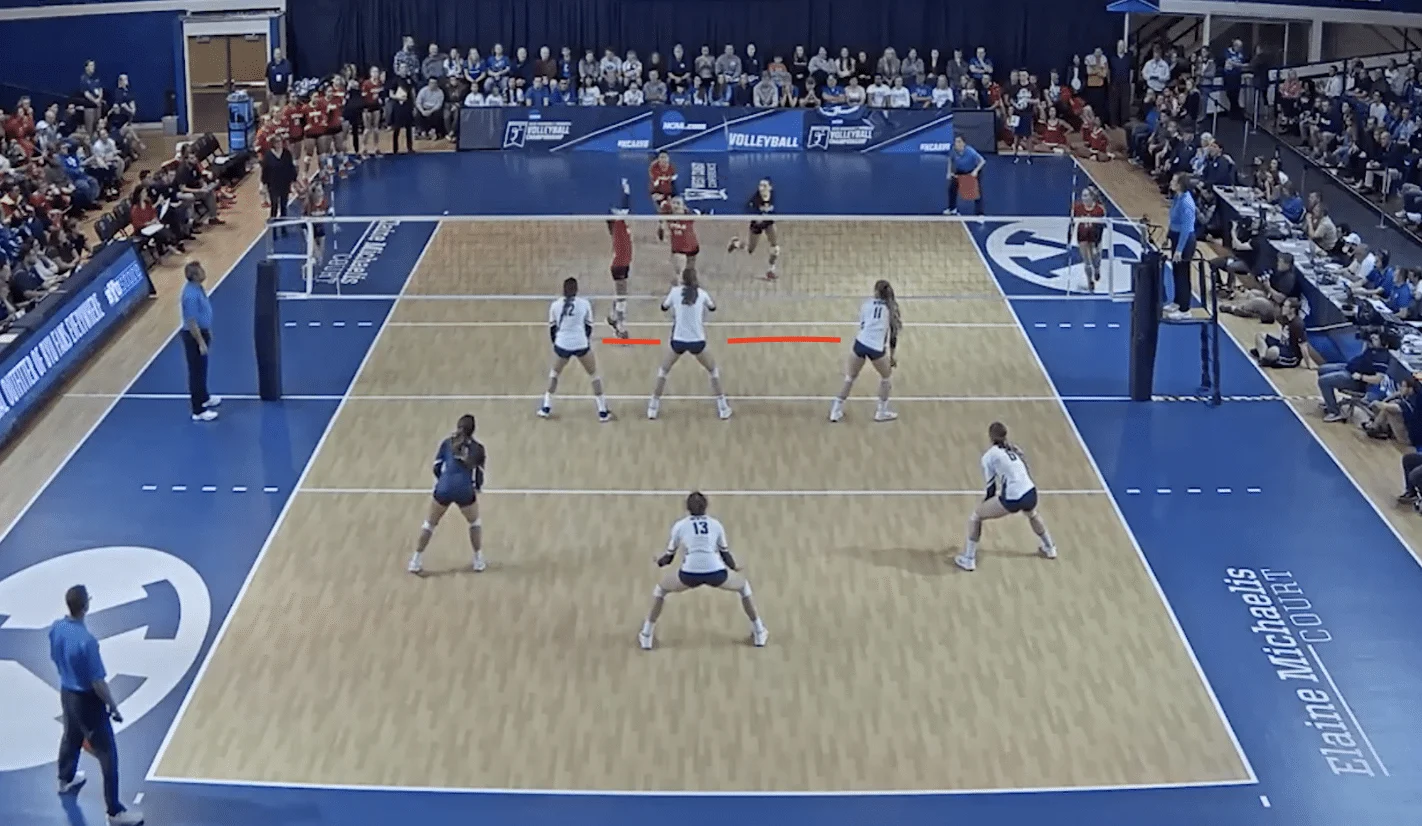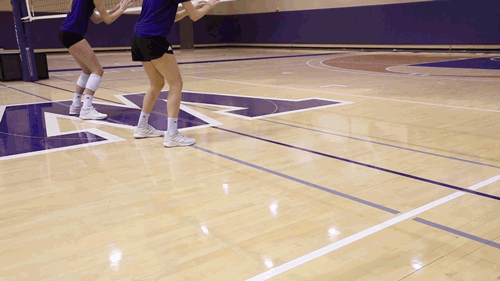blocking in volleyball – where to start?
Blocking in volleyball is a defensive play that is accomplished by 1, 2, or 3 front-row players jumping and pressing their arms over the net in an effort to “block” the opposing hitter. Blocking is one of the most worked-on skills out there. It’s complex, demanding, and requires great discipline to get good at.
Our founder, Carl McGown, was relentless when teaching blocking in volleyball. Because of his love for this skill, those that got to spend time with him also became pretty good at teaching it. His verbiage and the way he gave feedback was contagious.
With blocking, you are dealing with both team systems along with individual mechanics. We will cover both in this article, starting with our preferred team blocking system, the bunch read. The bunch read is a defensive blocking system that we’ve been teaching for over 25 years. Teams of all levels and genders, including top international programs have adopted this style as their preferred blocking setup in volleyball.
The premise behind the bunch read is that our blockers can be “bunched” closer to the middle of the court and then make fast, dynamic moves to the pin when needed. By having dynamic footwork patterns our blockers can “read and react” which allows us to have 2, and often times 3 blockers in front of most sets.
The blocking skills Required For an effective bunch read.
When setting up an effective bunch read blocking system in volleyball, we like to focus on these five areas.
- Proper spacing between your middle blockers and end blockers.
- Efficient footwork patterns that allow your blockers to move quickly.
- Armwork that allows your blockers to get up and over the net quickly and efficiently.
- Disciplined eyework (if you’re late or behind with your eyes your body will respond slower).
- Tactical positioning and postures
*The eyework is the most important, but I’ve found it’s really hard to train good eyes if your athletes can’t move well based on what they are seeing. In other words, your eyework development tends to be constrained by how well you can move as a blocker with a variety of footwork patterns.
Proper Spacing Between Your Middle and End Blockers
Below is a nice example of our baseline spacing when setting up in a bunch read (this can change with tactics). You will notice that the left front blocker is more “bunched” than the right front blocker. We like this because more often than not the right-side blocker will have to deal with the best attacker on the opposing team who gets set a lot. As a general rule, we say “elbows to elbows” on the left and “hands to hands” on the right.

You can also watch this video from a recent Gold Medal Squared Coaches Clinic with Keegan Cook explaining how UW volleyball team sets up spacing within the bunch read blocking system.
footwork patterns for bunch read blocking in volleyball
The basic footwork patterns that I want my blockers to have are:
- Jump in place
- 2-step shuffle
- 3-step shuffle (Q3)
- 2-step crossover (X2)
- 3-step crossover (X3)
We can rank the last three by the following categories:
- Get over the net quickly (Q3, x2, x3)
- Distance covered (x3, x2, Q3)
- Get over the net very high (x3, x2, Q3)
You can see that the Q3 gets you over fast, but it doesn’t go very far or very high. x3 gets you over very high and you can cover a lot of ground, but it’s the slowest of the three. x2 is the middle of the road option.
It’s a really big deal for all of your players to have good mechanics. The system really starts to work well when your team moves the same way and sees the same things. If some kids have certain mechanics and other kids have other mechanics, it gets to be a mess and it’s hard to be good.
The biggest issues I find with blockers are:
- Athletes don’t feel comfortable drifting on Q3, x2, and x3 moves. We have to cover ground in the air. Allow this to happen!
- Often times the first step in the x3 is too big. Small jab step, BIG RUNNING second step.
- The second step in the x2 and x3 is too small. BIG RUNNING second step.
- “Swimming” with their arms on their first step in the x3 (their arms come up above their waist). We want to lead out with our arms, but they have to stay low (like a spike approach) – no higher than our waist.
- Their arms don’t get fully extended (full swing) on their second step.
- They windmill their arms around when they start to get over. They need to face the hitter on their 3rd step, bend their elbows and come up inside when they get over.
- The blocker(s) split block or have their arms apart when they reach over. Good blockers have their arms together when they get across.
You’ll want to get these mechanics in place and then have the kids do them over and over and over during pre-practice warmups, etc. Just a note: these reps need to be supervised almost every time. They’ll get into bad habits and do screwy things if left unattended. My dad would always yell at me about not supervising pre-practice reps and he was right. If I walked over and watched players doing their routines, I almost always found little changes that needed to happen.
NOTE: Many of these blocking footwork patterns involve “swing blocking.” To learn more about that specific skill, please read our in-depth overview of all swing-blocking mechanics.
armwork requirements for bunch read blocking in volleyball
The first thing to decide is whether or not you want your blockers to start with their hands up, or if they can start hands down and bring them up as needed. Your blockers will be MUCH MUCH better at making a good move if they start from a hands-down position (just relaxed down by their waist) than if they start from hands up (at the level of their face). Below is a video outlining what we mean by this.
You’ll decide hands down or up based on how good your opponents pass and run their middle at a fast pace. Really good passing teams that run quick fast and often? Let’s start hands up. Otherwise, you might consider starting hands down.
I touched on this above, but we need our players to work really hard to always be trying to get across wherever they are. Don’t reach into seams, just get across where you are. That message is really powerful and very important. If you are big/long/athletic enough to be across and you want to “upgrade” to a better spot, you get to do this, but you don’t get to reach if it takes you parallel to the net. Early in their development, you’ll want to just start out with getting straight across and then seeing how it goes.
I also am very strict about keeping your arms together and getting your head and eyes up. I am not a fan of spreading our arms to try and “split” block or any of that – it just creates too many bad surfaces for the hitter to tool.
NOTE: Many of these blocking footwork patterns involve “swing blocking.” To learn more about that specific skill, please read our in-depth overview of all swing-blocking mechanics.
Eyework Requirements For bunch read blocking in volleyball
Obviously, the big deal here is being good with our eyes, and we want to a) get off the pass really early and get on the setter for a long time and b) get to the hitter at some point. The block gets to see the set a little longer than the back row players, but I like if they are seeing the hitter by the time they are jumping. If a team is playing really fast, we probably get on the hitter sooner than that.
Again, it’s really hard to train eyes if they don’t have a good toolbox of moves. They need to be able to decide in a millisecond “where do I need to go, and how much time do I have to get there?” and then use the appropriate footwork instinctively. This is where we prefer a little bit of blocked training, at least to start.
If we start by telling them “we are setting left”, then they can focus on making good mechanical moves and not worry about making a read. If they are stressed about the read, their mechanics will always revert back to what they have done in the past and it’s hard to make changes.
You can even tell them where you are setting it and what move you want – “we are setting left, and Sally, you have to make an x2 move”. Then you increase the variables (and speed) as you get better and better. More hitters to defend and faster sets. All the while you are coaching mechanics and eyes. What did you see? What did your arms do on your first step? Did they swim? How did you get across? Did you see the hitter? Etc.
Here’s a nice overview of Keegan Cook talking about eyework with his athletes.
Common Tactics Utilized in a Bunch Read Blocking System
Once you get a solid handle on the spacing and fundamentals of swing blocking in volleyball, we would encourage you to explore some basic tactics. Being able to recognize the difference between a medium pass and a perfect pass is a really big part of blocking tactics, but we will save that for another conversation.
At the high school and club level, you really won’t need very many tactics. When you get into college and international volleyball, you will find more teams performing a wider range of tactics (probably too many in our opinion).
The tactics we would recommend for a high school or club team would be…
- Load: If our wings weren’t going to help defend the middle, they could drop hands (yours might already be dropped?) and start getting ready to run to the pin hitter.
- Dedicate: If we needed a blocker to take a shuffle-step towards a really good hitter, we would “Dedicate” towards them. This happened while the ball was in the air on the pass, and then the blocker would get right back onto the setter for a read. A good example of this is a middle that runs in the gap that we step towards with our MBs.
You might want to trap or throw in the occasional commit block, but generally speaking, you can be great at blocking by reading and reacting to what’s in front of you.
Keep coaching these things when they are playing live volleyball! This is where the magic happens.
We’d try to get as many opportunities to put blockers in front of hitters as we could during a practice, even if it was just one blocker in a queen of the court drill, or a blocker when we were playing doubles, etc.
If you spend 15-30 minutes a day mastering these skills you should see some nice improvements with your team. Lastly, during the learning phase allow your athletes to be late! This is a tough skill with a lot of processing and discipline required. If they make a good read but are a little late to the pin that’s OK!!! They will get faster as they get more comfortable with the mechanics.
We hope this helps! Let us know if you have any questions.
